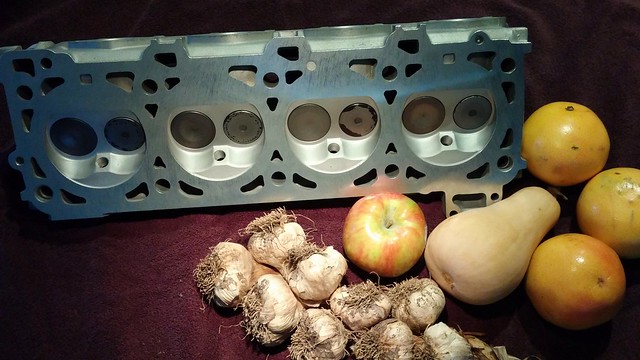Problem #1: The oil pressure gauge's illumination light isn't working. That's annoying for a brand new gauge.
First I thought I'll have to order a bag of teeny light bulbs.
Second I thought that maybe the bulb is an LED one, just put in backwards. I may have swapped it when I had a little trouble with wiring it. One of the spade connections had pushed into the housing (also very annoying and cheap), allowing the bulb to drop and swim around inside the gauge itself. I retrieved the bulb and stuck it all back together. So I couldn't be sure if I had done that incorrectly.
Knowing I wouldn't be able to sleep unless I knew what was going on, I went out to the car. I turned on the power. The gauge lights came on (except that one). They are going to need to be on their own switched circuit, by the way. And as I wiggled the bulb a bit, it illuminated. I brought it inside for a closer look. I think that when the bulb fell out, or during its replacement, its contacts had slid aside, and weren't making positive contact in the socket. I'll put the bulb back in properly tomorrow and all will be forgiven.

Definitely not an LED lamp. VDO-branded LED upgrade bulbs are $15 apiece (!)
Problem #2: The Oil Pressure Sender Is Being Difficult
The oil pressure gauge goes to full peg on when I turn on the ignition but not running. But in that state, it should read zero psi. The idiot light, wired separately, is on, and that's normal (see pic below to see some obnoxious red LED output). But when I start the engine, the gauge drops to 80 psi (which equals 5.5 bar and is pretty normal) and as the engine warms up it goes down to around 60 or 65 psi (4.1 bar, also normal). The idiot also light goes out as soon as the engine starts, thank goodness. Normal.
I think I will have to order a new pressure sender. I believe the sender isn't really working all that well and doesn't make any contact until it gets a good jolt of 13 volts. A new one would probably work properly. What I have to figure out is exactly which thread size my car wants, and what number of bars or PSI is meant to trigger my idiot light. I could buy the OEM part for $120, or I could buy a VDO aftermarket sender for $40 or so. Same part.

^^ This is what it looks like when the mains are turned on but ignition is off.

And this is what it looks like when the ignition switch is turned on but the engine hasn't been started.
The green light is wired not to the output of the ignition switch itself, but to the ignition relay output seen at the start button. It's an instant indication of what that relay is doing.
Problem #3: The alternator isn't excited.
The blue light is the start button. This is an interesting one because it works just like the OEM warning light. It is powered by the ignition circuit (battery voltage) and the other end goes to the alternator's "exciter" connection, which is zero volts (ground) while the alternator isn't doing anything. When you press the button, it completes the starter motor solenoid, which starts the engine. As the alternator spins up, it needs to see a bit of a load at the exciter connection to begin charging. If it does, and it starts charging, the voltage on the exciter connection comes up to full alternator output voltage. Which becomes the same as battery voltage. And the start button LED goes out because the voltage becomes essentially the same at both ends (net zero volts).
Except in this case, it didn't go out right away. The start button stayed on, and the voltmeter continued saying 11.5 volts. Meaning the alternator wasn't doing anything. Fortunately as soon as I revved the engine just a bit, the light went out, and the voltmeter started reading 13.5 volts. YAY!
So I think the reason for the hesitation is that the integrated resistor on the LED is only 50 ohms, while the little 3-watt warning light bulb offers 120 ohms. I have a handful of power resistors including a couple 50 ohm ones. I just don't quite know how to add them to the circuit. Maybe a 50 ohm in series would help. Hopefully the LED would still illuminate with that voltage drop. It's pretty bright, after all.
Any thoughts?


































































